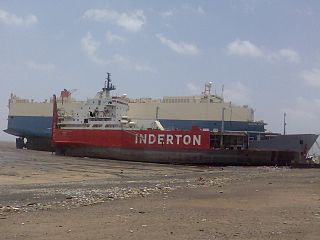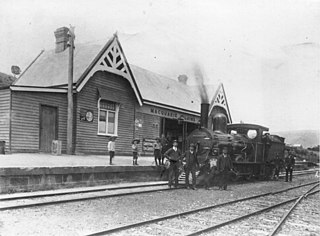
Ebor is a village on Waterfall Way on the Northern Tablelands in New South Wales, Australia. It is situated about 80 km (50 mi) east of Armidale and about a third of the way between Armidale and the coast. Dorrigo to the east is 46 kilometres (29 mi) away with the Coffs Coast 55 kilometres (34 mi) away along Waterfall Way. In the 2016 census, Ebor's zone had a population of 166.

The Nightcap National Park is a national park located in the Northern Rivers region of New South Wales, Australia. The 8,080-hectare (20,000-acre) park was created in April 1983 and is situated 35 kilometres (22 mi) north of Lismore. The national park is classed by the IUCN World Commission on Protected Areas as Category II and is part of the Shield Volcano Group of the World Heritage Site Gondwana Rainforests of Australia inscribed in 1986 and added to the Australian National Heritage List in 2007.

Topaz Road is a national park in Far North Queensland, Australia, 1,348 km northwest of Brisbane. It covers an area of 0.4 km². According to the Queensland Government, "Topaz Road National Park protects remnant rainforest in the upper Johnstone River catchment. The park and nearby nature refuges form a network of protected areas that adjoin Wooroonooran National Park, providing habitat connectivity for a wide variety of Wet Tropics species."
The Australian Department of the Environment was a department of the Government of Australia that existed between September 2013 and July 2016. The department was charged with responsibility for developing and implementing national policy, programs and legislation to protect and conserve Australia's environment and heritage.

The Australian Bureau of Statistics (ABS) is the independent statistical agency of the Government of Australia. The ABS provides key statistics on a wide range of economic, population, environmental and social issues, to assist and encourage informed decision making, research and discussion within governments and the community.

The Environment Protection and Biodiversity Conservation Act 1999 is an Act of the Parliament of Australia that provides a framework for protection of the Australian environment, including its biodiversity and its natural and culturally significant places. Enacted on 17 July 2000, it established a range of processes to help protect and promote the recovery of threatened species and ecological communities, and preserve significant places from decline. The EPBC Act replaced the National Parks and Wildlife Conservation Act 1975.
Huon Commonwealth Marine Reserve is a 9,991 km2 marine protected area within Australian waters. The former Tasmanian Seamounts Marine Reserve created in 1999 was incorporated into the Huon reserve in 2007, and is part of the South-east Commonwealth Marine Reserve Network.

Corindi Beach, pronounced Cor-in-"dye" although Cor-in-"dee" is widely used recently, historically also known as Pipeclay Beach until a name change in 1954, Corinda until a forced change to be provided postal service to avoid confusion or by Red Bank as Corindi River was formerly known, is a beach and small seaside farming town located on the Mid North Coast of New South Wales, Australia. The village is situated 33 kilometres (21 mi) north of Coffs Harbour and 50 kilometres (31 mi) south of Grafton. The original village of Corindi is slightly north along the Pacific Highway at Post Office Lane and Casson Close. Corindi means "grey" in local indigenous language referring to the pipeclay on the beach.

A ship graveyard or ship cemetery is a location where the hulls of scrapped ships are left to decay and disintegrate, or left in reserve. Such a practice is now less common due to waste regulations and so some dry docks where ships are broken are also known as ship graveyards.
Hobartiidae is a family of beetles, in the suborder Polyphaga.
Protocucujidae is a family of beetles, in the suborder Polyphaga.

Brickendon Estate is a farm estate located in Longford, Tasmania. It is one of the two main ancestral homes of the Archer family, prominent local pioneers and politicians. Founded in 1824, it consists of a village and manor house, as well as 465ha working farm. The main manor was built in 1829-1830 in a Georgian style.

Australian Convict Sites is a World Heritage property consisting of 11 remnant penal sites originally built within the British Empire during the 18th and 19th centuries on fertile Australian coastal strips at Sydney, Tasmania, Norfolk Island, and Fremantle; now representing "...the best surviving examples of large-scale convict transportation and the colonial expansion of European powers through the presence and labour of convicts."
The Australian Faunal Directory (AFD) is an online catalogue of taxonomic and biological information on all animal species known to occur within Australia. It is a program of the Department of Sustainability, Environment, Water, Population and Communities of the Government of Australia. By September 20, 2016, the Australian Faunal Directory has collected information about 122,898 species and subspecies. It includes the data from the discontinued Zoological Catalogue of Australia and is regularly updated. Started in the 1980s, it set a goal to compile a "list of all Australian fauna including terrestrial vertebrates, ants and marine fauna" and create an "Australian biotaxonomic information system".
Roadside conservation is a conservation strategy in Australia and other countries where Road verge flora and habitats are protected or improved. The general aim is to conserve or increase the amount of native flora species; especially where that work will lead to higher conservation value, for example providing food or habitat for rare or endangered native fauna.

Gretna is a small township in the Derwent Valley of Tasmania, Australia. It was formerly known as Macquarie Plains. Its population is unavailable, as Gretna is statistically located inside Hamilton, Tasmania, and census data for such a gazetted locality is not released. It has a postcode of 7140.
Australian marine parks are marine protected areas located within Australian waters and are managed by the Australian government. These waters generally extend from three nautical miles off the coast to the outer limit of Australia’s Exclusive Economic Zone at 200 nautical miles while marine protected areas located closer in-shore are the responsibility of the states or the Northern Territory.
The Ningaloo Marine Park is an Australian marine park offshore of Western Australia, and west of the Ningaloo Coast. The marine park covers an area of 2,435 km2 (940 sq mi) and is assigned IUCN category IV. It is one of the 13 parks managed under the North-west Marine Parks Network.













